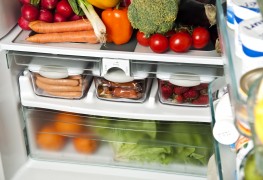If you want to save money on your energy bill, avoid costly repairs or replacement of a refrigerator and keep your food from spoiling longer, follow these four tips.
- Browse Categories
- All Tips
-
Home & Garden
- All
- Appliances
- Bathroom
- Cleaning
- Crafts
- Decorating
- Electrical
- Flooring
- Furniture
- Garage Door
- Gardening
- Green Living
- Heating
- Home Alarm Systems
- Home Maintenance
- Home Remedies
- Home Security
- Home Staging
- House Sitting
- Junk Removal
- Kitchen
- Lawn Care
- Lock Systems
- Moving
- Outdoor Living
- Pest Control
- Plumbing
- Renovation
- Roofing
- Snow Removal
- Storage
- Tools
- Tree Service
- Health
- Family
- Travel
- Auto
- More Tips
Your account is now active!

4 tips for simple refrigerator maintenance
July 28, 2015

1. Defrost the drip drain
- In frost-free freezers, a hose carries moisture out of the freezer into a drain pan at the bottom of the unit. If the hose gets clogged with algae or food, the defrost cycle will cause the melted ice to overflow and drip into the area where food is kept.
- Here's a once-a-year trick to keep your defrost drain in good working order: unplug the refrigerator and empty the freezer. Pop the freezer floor out (your manual will explain how to do this), find the drain hole, and remove excess ice from the floor of the freezer and tray. Mix 2 litres (1/2 gallon) of hot water with 125 millilitres (1/2 cup) of chlorine bleach and pour the solution into the hose a little bit at a time — you may not need to use all of the solution.
- When the ice is melted and flowing down the drain hole, blow down the drain hole with a small rubber tube to force the leftover particles out.
- When the hose allows a free flow, rinse it with clear water.
- Finally, empty, clean and dry the drip pan.
2. Buy energy efficient fridges
- Refrigerators that are sold today use 40 percent less energy than those that were sold in 2001. The Association of Home Appliance Manufacturers claims that a new, 20.6-cubic-foot refrigerator with a top freezer uses no more electricity than a 75-watt lightbulb.
- Twentieth-century models may well account for as much as 15 percent of your electric bill; to encourage customers to replace their old units with more energy-efficient ones, some utility companies offer incentive rebates. That new model could pay for itself faster than you'd think!
3. Check gaskets
- If the gaskets on your refrigerator door aren't sealing tightly, your food will spoil more quickly, and your energy bill will skyrocket.
- Here's how a five-dollar bill can save you big bucks: twice a year, put a five-dollar bill between the door and the refrigerator unit and close the door. Try to pull the bill out. (Try this trick in several places around the door.) If there's no resistance, the gasket's not working.
- If the gasket appears stiff or cracked, replace it.
- If your old gasket looks good, lightly coat the flat surface on the more vulnerable hinge side with petroleum jelly to keep it from sticking.
- If your gasket's in good shape but flunks the five-dollar-bill test, the door may be warped or sagging. To fix it, take everything off the door shelves, loosen the screws behind the gasket or on the plate on top of the door, then grasp the door and flex it until it closes flush with the refrigerator. This is easier to do with a helper. Tighten the screws to hold the door in place.
- Most replacement gaskets in newer-model refrigerators simply snap into place, much like the seal on a plastic zipper storage bag. Soak new gaskets in warm water to make them more flexible and easier to install.
4. Change your filter
- If the ice from your ice maker or water from your refrigerator's spigot tastes funny, changing the filter may help. You can purchase them online or in appliance parts stores. Installing a new filter will take you about two minutes — you snap out the old one and snap in the new one.
- Swap in a new filter annually. If your water quality is bad, change it every six months.
By following these four simple pieces of advice, you may notice a dip in the cost of your electrical bill each month and your foods stay a bit fresher for longer.
National advertising powered by Mediative.com. Yellow PagesTM, Walking Fingers & DesignTM, YP.caTM, Find. & DesignTM, YellowPages.caTM, Canada411TM and YP ShopwiseTM are trademarks of Yellow Pages Digital & Media Solutions Limited in Canada. All other trademarks are the property of their respective owners. Copyright © 2018 Yellow Pages Digital & Media Solutions Limited. All Rights Reserved.
More Tips
The material on this website is provided for entertainment, informational and educational purposes only and should never act as a substitute to the advice of an applicable professional. Use of this website is subject to our terms of use and privacy policy.






